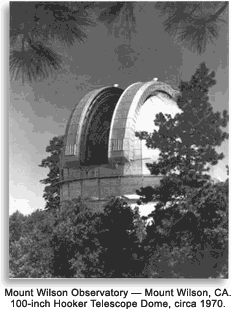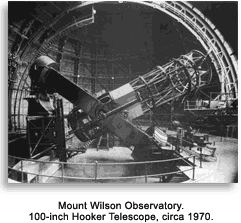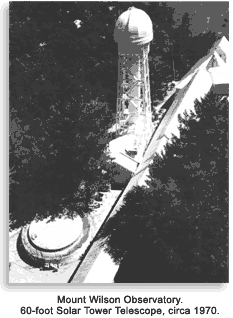 Mount Wilson Observatory is located in the San Gabriel Mountains, overlooking Pasadena. Built with funds provided by the Carnegie Institution of Washington in 1904, the observatory houses two telescopes that were the largest in the world at the time, and has been involved in many seminal discoveries in astronomy.
When George Emery Hale founded the observatory in December 1904, it was one of the original scientific enterprises of the Carnegie Institution of Washington. Originally designated the Mount Wilson Solar Observatory, the word "solar" was dropped in 1919. It housed the first 60-inch nighttime telescope and later the first 100-inch nighttime instrument, which remained the largest in the world until the 200-inch telescope at Mount Palomar Observatory was inaugurated in 1949. Mount Wilson also contains two solar tower telescopes (60 feet and 150 feet)that collect daily data on the sun and represent the world's longest continual record of the sun.
Mount Wilson Observatory is located in the San Gabriel Mountains, overlooking Pasadena. Built with funds provided by the Carnegie Institution of Washington in 1904, the observatory houses two telescopes that were the largest in the world at the time, and has been involved in many seminal discoveries in astronomy.
When George Emery Hale founded the observatory in December 1904, it was one of the original scientific enterprises of the Carnegie Institution of Washington. Originally designated the Mount Wilson Solar Observatory, the word "solar" was dropped in 1919. It housed the first 60-inch nighttime telescope and later the first 100-inch nighttime instrument, which remained the largest in the world until the 200-inch telescope at Mount Palomar Observatory was inaugurated in 1949. Mount Wilson also contains two solar tower telescopes (60 feet and 150 feet)that collect daily data on the sun and represent the world's longest continual record of the sun.
 In 1919, Hale brought the Snow Solar Telescope from Yerkes Observatory, which he had helped found in 1897 in his home state of Wisconsin, to the friendlier skies of southern California. There he established the world's foremost astronomical research group. Several innovations in astronomical thinking come from Mount Wilson, including the concepts that the sun is not the center of the Milky Way, that many other galaxies exist outside the Milky Way, that they represent a variety of ages, and that they all appear to be moving away from each other.
In 1919, Hale brought the Snow Solar Telescope from Yerkes Observatory, which he had helped found in 1897 in his home state of Wisconsin, to the friendlier skies of southern California. There he established the world's foremost astronomical research group. Several innovations in astronomical thinking come from Mount Wilson, including the concepts that the sun is not the center of the Milky Way, that many other galaxies exist outside the Milky Way, that they represent a variety of ages, and that they all appear to be moving away from each other.
 Hale died in 1937. The most famous astronomer associated with Mount Wilson, Edwin Hubble, worked at the observatory between 1919 and his death in 1953, except for a brief stint during World War II. Prior to 1986, the Mount Wilson Observatory was managed as part of the Hale Observatories. Since 1986, management of the Mount Wilson Observatory has been under the control of the Mount Wilson Institute. As of 2005, guest institutions operating on the observatory grounds included the University of California, Berkeley; Georgia State University, University of Illinois at Champaign-Urbana, the University of California, Los Angeles; and the University of Southern California.
Hale died in 1937. The most famous astronomer associated with Mount Wilson, Edwin Hubble, worked at the observatory between 1919 and his death in 1953, except for a brief stint during World War II. Prior to 1986, the Mount Wilson Observatory was managed as part of the Hale Observatories. Since 1986, management of the Mount Wilson Observatory has been under the control of the Mount Wilson Institute. As of 2005, guest institutions operating on the observatory grounds included the University of California, Berkeley; Georgia State University, University of Illinois at Champaign-Urbana, the University of California, Los Angeles; and the University of Southern California.